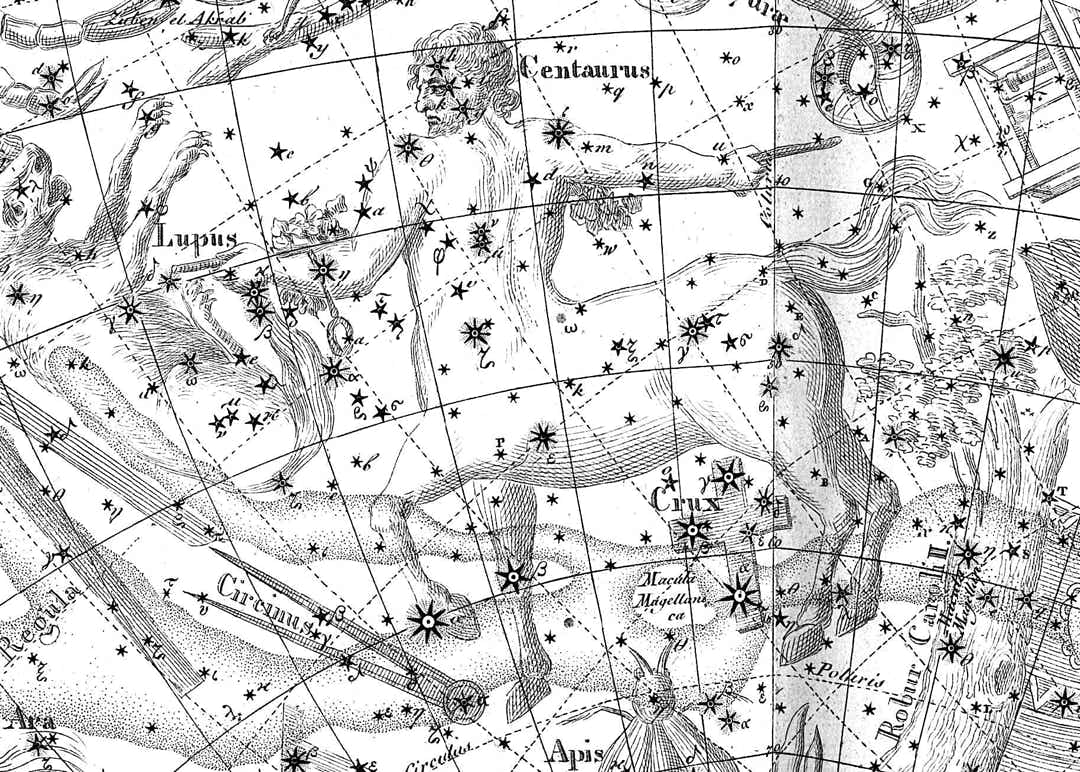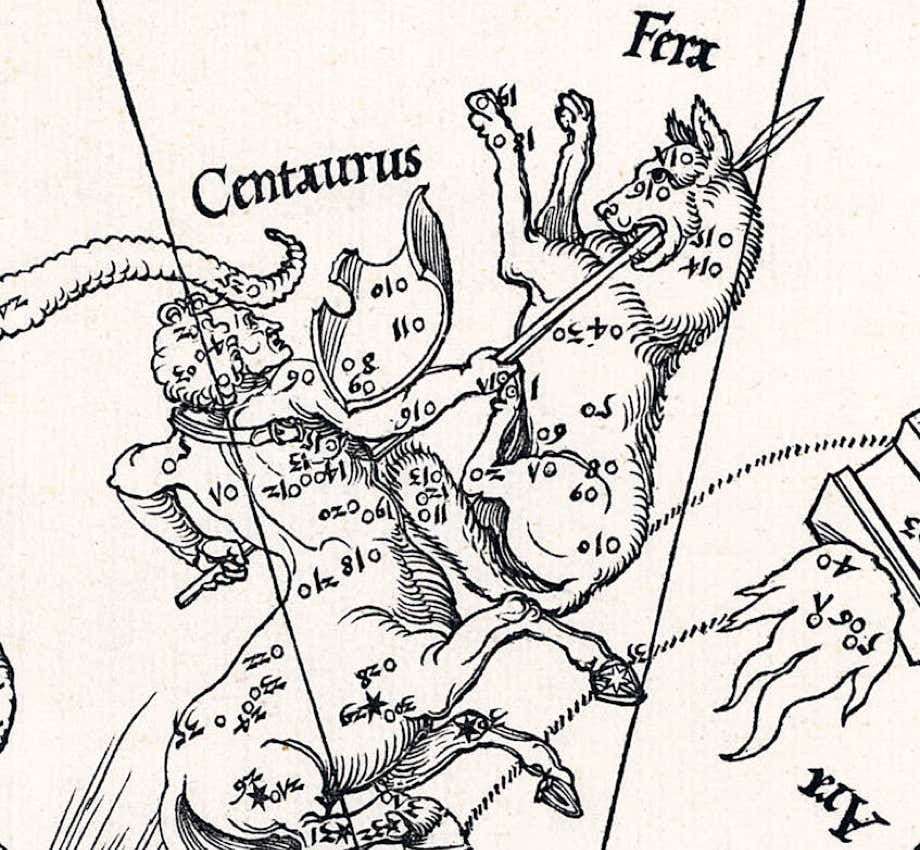
Genitive: Centauri
Abbreviation: Cen
Size ranking: 9th
Origin: One of the 48 Greek constellations listed by Ptolemy in the Almagest
Greek name: Κένταυρος (Kentauros)
Centaurs were mythical beasts, half-man, half-horse. They were a wild and ill-behaved race, particularly when the wine bottle was opened. But one centaur, Chiron, stood out from the rest as being wise and scholarly, and he is the one who is represented by the constellation Centaurus (Κένταυρος in Greek).
Chiron was born of different parents from the other centaurs, which accounts for his difference in character. His father was Cronus, king of the Titans, who one day caught and seduced the sea nymph Philyra. Surprised in the act by his wife Rhea, Cronus turned himself into a horse and galloped away, leaving Philyra to bear a hybrid son.
Chiron grew up to be a skilled teacher of hunting, medicine, and music; his cave on Mount Pelion in eastern Greece became a veritable academy for young princes in search of a good education. Chiron was so trusted by the gods and heroes of ancient Greece that he was made foster-father to Jason (of Argonauts fame) and Achilles; but perhaps his most successful pupil was Asclepius, son of Apollo, who became the greatest of all healers and is commemorated in the constellation Ophiuchus.
Centaurus from Chart II of the Uranographia of Johann Bode (1801).
The centaur holds a long pole called a thyrsus on which is impaled Lupus,
the wolf. Alpha Centauri, the closest star to the Sun, marks the centaur’s
forefoot while Crux, the Southern Cross, is found under his hind quarters.
The globular cluster Omega (ω) Centauri can be seen as a stippled patch at
the base of the centaur’s back, where it joins the body of the horse.
Sad death of the centaur
For a creature who did so much good during his lifetime, Chiron suffered a tragic death. It arose from a visit paid by Heracles to the centaur Pholus, who entertained him to dinner and offered him wine from the centaurs’ communal jar. When the other centaurs realized their wine was being drunk they burst angrily into the cave, armed with rocks and trees. Heracles repulsed them with a volley of arrows. Some of the centaurs took refuge with Chiron, who had been innocent of the attack, and an arrow of Heracles accidentally struck Chiron in the knee. Heracles, concerned for the good centaur, pulled out the arrow, apologizing profusely, but he already knew that Chiron was doomed. Even Chiron’s best medicine was no match for the poison of the Hydra’s blood in which Heracles had dipped his arrows.
Aching with pain, but unable to die because he was the immortal son of Cronus, Chiron retreated to his cave. Rather than let him suffer endlessly, Zeus agreed that Chiron should transfer his immortality to Prometheus. Thus released, Chiron died and was placed among the stars. Another version of the story simply says that Heracles visited Chiron and that while the two were examining his arrows one accidentally dropped on the centaur’s foot.
Centaurus in the sky
In the sky, the centaur is visualized as about to sacrifice a wild animal (the adjoining constellation Lupus) on the altar, Ara. Eratosthenes says that this is a sign of Chiron’s virtue. Aratus and Eratosthenes said that the animal was carried in the centaur’s hands, and Ptolemy in the Almagest described its hind leg as lying next to the right hand of Centaurus which implies that it was being held by the feet, but constellation illustrations usually show it as impaled on a pole or spear.
Eratosthenes also offered an alternative scene: in this, the centaur holds not a wild animal but a wine skin, from which he is about to pour an offering onto the altar. The wine skin is in his right hand while in his left is a thyrsus, which is a stick of fennel wrapped in ivy and vine-leaves, tipped with a pine cone. Such poles were carried by the followers of the wine god Dionysus and could also be used as spears, which is perhaps how the animal came to be visualized as impaled on a spear. In Johann Bayer’s depiction of 1603 the wine skin dangles from the centaur’s left arm.
Aratus and Hyginus did not mention the thyrsus or the wine skin, only the wild animal, but Ptolemy allocated four stars to the thyrsus (the present-day Psi, a, b, and c Centauri) and as a result it is usually included in depictions of the constellation. A different interpretation was given by Albrecht Dürer who, in his celestial hemispheres of 1515, placed these four stars not on a thyrsus but on a shield awkwardly positioned over the centaur’s arm, quite separate from the pole spearing the animal.
The massed stars of Centaurus and Lupus were known to the Arabs as al-shamārīkh, meaning stalks of dates, from their resemblance to the clusters of fruit on a date palm.
Stars and a globular cluster
Centaurus contains the closest star to the Sun, Alpha Centauri, 4.3 light years away. Alpha Centauri is also known as Rigil Kentaurus, from the Arabic rijl qanṭūris meaning ‘centaur’s foot’; Ptolemy described it as lying on the end of the right front leg. To the naked eye it appears as the third-brightest star in the sky, outshone only by Sirius and Canopus, but a small telescope reveals it to be double, consisting of two yellow stars like the Sun. A third, much fainter companion star is called Proxima Centauri because it is just over a tenth of a light year closer to us than the other two, but is only visible telescopically.
Beta Centauri is called Hadar, from an Arabic name signifying one member of a pair of stars; Ptolemy described it as lying on the centaur’s left knee. Alpha and Beta Centauri act as pointers to Crux, the Southern Cross, which on modern maps lies under the centaur’s body. In Ptolemy’s day, the stars of Crux were part of the hind legs of Centaurus.
Centaurus also contains the largest and brightest globular star cluster visible from Earth, Omega Centauri. Ptolemy, in the Almagest, catalogued this as a 5th-magnitude star which, he said, lay where the back of the human half of the centaur joined the horse’s body (see Bode’s chart, above). Ptolemy did not mention its nebulous appearance; its first identification as a cluster was due to Edmond Halley in 1678. In all, Ptolemy catalogued 37 stars in Centaurus, five of which later became part of Crux.
Bayer’s sequence of Greek letters in Centaurus was scrapped by Lacaille, who replaced it with the letters we use today in his southern catalogue of 1756.
The changing visibility of Centaurus and the Southern Cross
It might seem puzzling that Alpha and Beta Centauri and the stars of Crux were known to the ancient Greeks, when they are now too far south to rise above the horizon from Mediterranean latitudes. The reason is the effect known as precession, caused by a wobble of the Earth’s axis in space, which slowly changes the position of the celestial poles. In Ptolemy’s day, the south celestial pole lay some 10° from where it is now, in a direction away from Centaurus. As a result, the stars of Centaurus and its neighbours were about 10° higher in the Greek sky than they are today. This difference was enough to make these stars observable from ancient Greece. They were then gradually lost from view because of precession until rediscovered by European navigators travelling south in the 16th century.
Alpha Centauri has one of the largest proper motions of any naked-eye star, and this motion is gradually carrying it towards Beta Centauri as seen from Earth. In Ptolemy’s day the two were over 6° apart. Currently the stars are separated by about 4½°, but around 4,000 years from now they will be little more than ½° (one Moon diameter) apart in our skies, creating a brilliant naked-eye pairing before Alpha moves away again.
Chinese associations
Chinese astronomers recognized three extensive constellations among the stars of Centaurus, although the exact identities of most of the stars involved is uncertain. The most prominent of these constellations was Kulou, a military depot or arsenal for storing weapons and armour. Six stars formed the walls while another four at the southern end were a tower. The stars in the wall probably included Zeta, Eta, Theta, Iota, and Gamma Centauri. Sun and Kistemaker equate the four stars of the tower with the stars of Crux, the Southern Cross, although other sources place them farther north. Most likely the identities changed with time as precession took this part of the sky permanently below the Chinese horizon.
Scattered around Kulou were the 15 stars of Zhu, arranged into five groups of three, representing poles for tethering cavalry horses. In the middle of Kulou was Heng, a parade ground for troops, consisting of Mu, Nu, Phi, and Chi Centauri. Two stars formed Nanmen, the southern gate of the arsenal, but sources disagree as to their identity; different charts show the two stars as either Alpha and Beta Centauri, Alpha and Epsilon Centauri, or Epsilon and Xi Centauri. To the north of Kulou was another gate, Yangmen, representing a fortified pass or border crossing; this also consisted of two stars, probably b and c Centauri, although some sources place Yangmen farther north in Hydra. Extending the military theme in this area, Kappa Centauri was part of a large constellation called Qiguan, representing imperial guards or cavalry officers, most of which lay in neighbouring Lupus.
Another major constellation in this area was Qifu, a storehouse for musical instruments. Qifu consisted of 32 stars scattered over the rich Milky Way area of Centaurus, Carina, and Vela. It had the second-largest number of stars of all Chinese constellations (the most populous of all was Yulinjun in Aquarius, with 45). Sun and Kistemaker note that the original stars of Qifu sank below the southern horizon over time because of precession and later maps placed it too far north – in the case of the Dunhuang star chart, it is 20° too far north. Its stars were depicted in a stylized criss-cross pattern, making it impossible to work out which stars were intended.
Qingqiu, ‘green hill’, representing either a southern barbarian country or a legendary island in the southern sea, is another migrating constellation. Originally a ring of seven faint stars north of Gamma Centauri, it got pushed northwards into Hydra in response to the effects of precession.
© Ian Ridpath. All rights reserved
Ptolemy in the Almagest listed four 4th-magnitude stars which he said lay in the thyrsus or pole carried by Centaurus. Albrecht Dürer on his southern celestial chart of 1515 placed these stars not in the thyrsus but in a shield resting awkwardly on the centaur’s arm. Dürer numbered them 8, 9, 10, and 11, the order they were listed in the Almagest; we now know them as Psi, a, c, and b Centauri respectively. Dürer’s chart shows the constellations as they would appear on a celestial globe, i.e. back to front from the way we see them in the sky. North is at the top.




